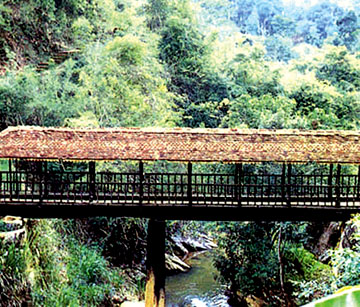|
observer |
|
|
|
|
|
OTHER LINKS |

|

|

|
400-year-old Bogoda BridgeToday bridges are built of concrete and steel. Fortunately one can get a chance to see one of Sri Lanka's oldest wooden bridges - "Bogoda Bridge" at the Bogoda village in the Badulla District.
Bogoda, with its ancient temple and wooden bridge lies some 30 kilometres from Bandarawela and 10 km from Badulla, off the Hali-Ela junction. Believed to be the oldest surviving wooden bridge in the world, the Bogoda bridge dates back to the 1600s, but the temple just by it, has a much longer history, going back to the 1st century BC. The Bridge belongs to the Dambadeni Era in the 16th century, and is over 400 years old. The special feature of this is that it is made entirely out of wood and is full of wood carvings. According to the legend, not a single steel nail has been used in the construction of the bridge. This bridge is around 50 feet in length and about five feet wide. The bridge built across the Gallanda Oya, as it gushes down the mountain to meet Uma Oya in Uva Paranagama (a tributary of the Mahaweli Ganga) is on an ancient route, which linked Badulla and Kandy. In the famous literary work, Sandesha Kavya (1612-1624), a chapter called Maga Salakunu spells out the route from Badulla to Kandy by foot, and invites other travellers to worship at the Bogoda temple on their way. Across the bridge lies the hamlet of Mahakumbura and the route then leads to Uva Ketawela. The bridge is still the road link used by many villagers around. The water which falls from the Gallanda oya flows under the bridge. The roof of the bridge is covered with Sinhala Tiles (Sinhala ulu) and two wooden fences decorated in various designs have been erected on either side. One can see the two big wooden poles that bear the entire weight of the bridge. Walk down the bridge and you can get into the adjoining temple - the Bogoda Raja Maha Viharaya. The templ e consists of caves believed to be King Walagamba's hideout. According to the legends the temple and bridge also have a long history. "The first bridge was probably a few logs thrown across the stream," said head prelate, Ven. Attampitiye Rahula Thera. The base consists of a single standing log, a huge kumbuk tree 35 feet in height. Three huge jak trunks were flung across the stream to form the platform, on which, during the Kandyan era the elaborate wooden structure came into being. The roof has distinctly Kandyan style tiles and even the modest decor on the wooden pillars holding up the roof is reminiscent of that era. Ven. Rahula, who came to the temple when he was just 11 has a deep attachment to the place. He remembers a time in 1984, when the waters of the Oya rose and the bridge tilted to a side. Unable to summon any kind of official support to resurrect the bridge in a hurry, Ven. Rahula turned to a British planter from an estate nearby. With strong cables, he and the prelate managed to sustain the bridge until the Department of Archaeology came in and concreted its base. Ven. Rahula said there were two reasons for the roof over the bridge. One for shelter and second for protection from the wilderness. The bridge was also used as an ambalama during the olden days when travelling took weeks of hard walking. The priest's dwelling too is an old crumbling building of the Kandyan era, complete with a meda midula and pillared verandahs. But dating beyond all these is the temple itself, its history going back a good thousand years to the Anuradhapura era. |
 The Bogoda bridge is believed to have been constructed by a father
and son team of wood craftsmen who were also responsible for the
ambalama at Panapitiya. History has it that the son was entrusted with
the task of completing the bridge and was told not to leave until the
father came to add the finishing touches. But having completed his task,
the son had set forth to meet the father. Since the ritual finishing
touches were not made before he left the site, the son was cursed and
died prematurely.
The Bogoda bridge is believed to have been constructed by a father
and son team of wood craftsmen who were also responsible for the
ambalama at Panapitiya. History has it that the son was entrusted with
the task of completing the bridge and was told not to leave until the
father came to add the finishing touches. But having completed his task,
the son had set forth to meet the father. Since the ritual finishing
touches were not made before he left the site, the son was cursed and
died prematurely. 







